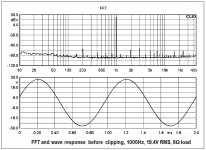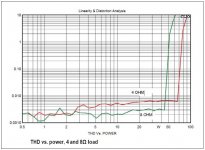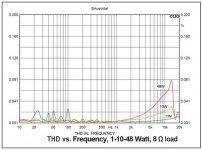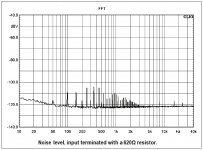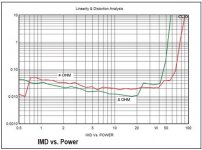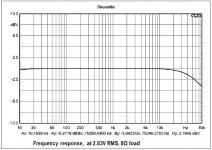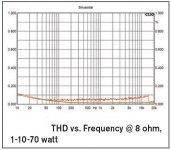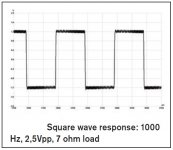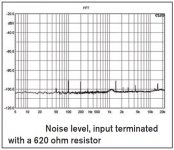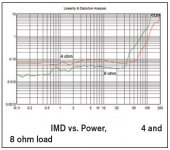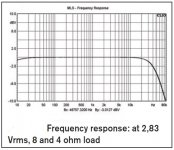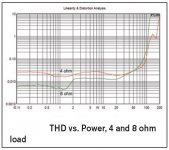one can only state the specs, not the implementation
Here's one:
It should have a proper balanced input, both for sound quality and practicality. It's worth it on practicality alone, as it makes the likelihood of wasting time getting annoyed by hum and ground loops a lot lower.
You can translate that into specs, for example CMRR >60dB dB @20kHz with 100R source impedance imbalance, an EMIRR spec (see TI appnotes) which would pretty much mandate HF filtering (X/Y caps), and "no pin1 problem" could be turned into a spec like "inject 1A AC current between chassis and pin1, that should manifest at the output with a level below... say -100dBV and nothing should burn".
It is safe to say, that challenge is present even with a 10x further reduction in specs: only 0.1% harmonic distortion.
I'm not buying on a THD % spec without at least an assortment of spectrum, THD vs level & frequency, IMD, etc. Because anything can be hidden in that 0.1%, it's an average over the measurement period, so it could be H2, or it could be nasty. Ideally what I'd like to see is worst case THD over operating points, but that is never measured.
Last edited:
Just to be practical, set of measurements.
Would you buy this amp without audition?
Would you buy this amp without audition?
Attachments
...you have to turn that into an analog signal with a DAC, name one that does 50bits SNR.
SNR is not the only point. Its also whether or not the N is audibly signal correlated. Only listening tests with trained, or otherwise very perceptive listeners will tell what the performance of some optimized neurons can detect in the way of insufficiently randomized patterns encoded in noise, given some time for 'fast' brain processing to learn how to perform the signal recognition task. The word 'fast' as used above refers to Kahneman's meaning as explained in "Thinking Fast and Slow."
As a reminder, Paul Frindle found some humans could detect very low levels of signal correlated noise. ESS found the same when they trained their executive team to recognize the effect on sound. Mallinson said he was the only one of them who couldn't learn to successfully do it in a blind ABX test (some of that info mentioned one of his youtube lectures; remaining parts of the story comes from other public sources).
With SD dacs its also about suppressing idle tones that show up as noise on an FFT; reason they don't show up is because they quickly sweep across the audio band in response the music signal. Happens so fast the idle tone energy is spread out across the audio band in the time it takes to acquire an FFT. Doesn't mean the brain can't perceptually interpret it as some kind of alteration to the music sound.
There is still some very interesting psychoacoustics research that should be done. We don't spend LIGO level funding, nor "probe to Mars' funding on hearing research. Nobody cares enough to pay for the cost of doing it well.
As always, people who hear certain things and other people don't hear the same things will always disagree with each other about what they consider to be reality. To each person its whatever they personally perceive, or else what they have been persuaded is credible science.
That said, training can help people learn to recognize sounds their brains have not learned to detect as meaningful signal. So, that could be one way to reduce the arguments, if people cared to learn. Mostly, audio forum people would apparently rather spend time arguing rather than spend time learning. Human nature, I guess.
Last edited:
Just to be practical, set of measurements.
Would you buy this amp without audition?
Price is the most important factor that we have assumed didn't exist. But I think I wouldn't even audition the amp with such measurement.
Just to be practical, set of measurements.
Would you buy this amp without audition?
All measurements into pure resistive load?
No for me even if so. I'd want 10x better allover... At least.
//
Last edited:
SNR is not the only point. Its also whether or not the N is audibly signal correlated. Only listening tests with trained, or otherwise very perceptive listeners will tell what the performance of some optimized neurons can detect in the way of insufficiently randomized patterns encoded in noise, given some time for 'fast' brain processing to learn how to perform the signal recognition task. The word 'fast' as used above refers to Kahneman's meaning as explained in "Thinking Fast and Slow."
Do you really not understand what I am saying? For the case in point (Chord's claims) the lower 20 or more bits can not contribute to anything (including noise), they can not be reproduced in an analog signal that anyone can listen too, there are no 50+bit DAC's.
Looking at a set of measurements only decides if I should bother listening to it or not. I'm also going to see how big it is, how heavy it is and whether it runs too hot or not. All these things matter to me. I look for reliability as well. Build quality is important.
Of course, if it is butt ugly, I'm probably not interested either. I'm not picky about appearance, but it does play a role in what I am willing to part with my dollars.
-Chris
Of course, if it is butt ugly, I'm probably not interested either. I'm not picky about appearance, but it does play a role in what I am willing to part with my dollars.
-Chris
Understood. If one thinks about reproducing exact signal amplitude at a precise point in time, it obviously can't be done to 50-bits of accuracy. However, if humans can hear the difference between 50-bits of processing verses 32-bits then there must be reason. We just have to find it. Taking a stab at working in that direction, trying to find the reason, I will resort to doing some speculative thinking as follows:
What if the 50-bits is not solely being used to calculate analog signal amplitude at some precise point in time? What if is needed to calculate in more dimensions at once than just instantaneous amplitude? In Chord dacs we are talking about modulating 170MHz clocked pulses to produce an average signal level in the audio band at a point in time which will be the analog output signal amplitude after being LP filtered.
We are not only trying to make the clocked pulse average level come out correctly at one precise point in time, however. We are trying to sufficiently randomize the way we produce the that average so that nothing about our randomization algorithm produces patterns recognizable to human brain 'fast' processing.
What if listening tests show it takes 50-bits of processing to modulate 170MHz clocked pulses over several minutes without leaving a humanly detectable pattern of pseudo-randomness, as opposed to true randomness (which has no algorithmic pattern)? I ask the question because Frindle found that humans can learn to detect a truncated signal despite attempts to hide the quantization distortion in pseudo-random noise extending down below -100dB. Humans learn to recognize the pseudo-random pattern as they are exposed to it over time. So, we have to calculate randomization for a long enough time, and enough complexly, so that its beyond the brain's ability to learn to recognize the pattern.
We create sufficient randomization over time using a modulator that is in part mathematically conceived of in the form of a filter. And a filter can be described in terms of its amplitude verses frequency. That's were the confusion arises about 50-bits. We are not using the so-called filter solely for shaping noise distribution. We are also using modulator architecture to sufficiently randomize 170MHz clocked pulses produce pseudo randomness over periods of minutes, at the same time it needs to produce randomization with zero or close to zero correlation to the audio signal (even though it is a complex function of the audio signal). If the algorithm takes a 50-bit filter to produce the necessary randomization and decorrelation, then maybe its silly to describe it as simply a noise shaping filter with -300dB dynamic range. Maybe its a red herring to think of it that way.
What if the 50-bits is not solely being used to calculate analog signal amplitude at some precise point in time? What if is needed to calculate in more dimensions at once than just instantaneous amplitude? In Chord dacs we are talking about modulating 170MHz clocked pulses to produce an average signal level in the audio band at a point in time which will be the analog output signal amplitude after being LP filtered.
We are not only trying to make the clocked pulse average level come out correctly at one precise point in time, however. We are trying to sufficiently randomize the way we produce the that average so that nothing about our randomization algorithm produces patterns recognizable to human brain 'fast' processing.
What if listening tests show it takes 50-bits of processing to modulate 170MHz clocked pulses over several minutes without leaving a humanly detectable pattern of pseudo-randomness, as opposed to true randomness (which has no algorithmic pattern)? I ask the question because Frindle found that humans can learn to detect a truncated signal despite attempts to hide the quantization distortion in pseudo-random noise extending down below -100dB. Humans learn to recognize the pseudo-random pattern as they are exposed to it over time. So, we have to calculate randomization for a long enough time, and enough complexly, so that its beyond the brain's ability to learn to recognize the pattern.
We create sufficient randomization over time using a modulator that is in part mathematically conceived of in the form of a filter. And a filter can be described in terms of its amplitude verses frequency. That's were the confusion arises about 50-bits. We are not using the so-called filter solely for shaping noise distribution. We are also using modulator architecture to sufficiently randomize 170MHz clocked pulses produce pseudo randomness over periods of minutes, at the same time it needs to produce randomization with zero or close to zero correlation to the audio signal (even though it is a complex function of the audio signal). If the algorithm takes a 50-bit filter to produce the necessary randomization and decorrelation, then maybe its silly to describe it as simply a noise shaping filter with -300dB dynamic range. Maybe its a red herring to think of it that way.
Last edited:
Hi Andrea,
If it is class D, I'm not interested yet. That technology has yet to mature. If it is a chip amp, the standard laws of physics apply and they generate a lot of heat in a small space. In addition, high current along the pins of a chip will not work well. Then you have temperature gradients across the chip.
For me, you need at least external output devices. So a voltage amplifier chip might work, but so far I like the classic discrete design, but I am also looking for over 100 wrms per channel. That will generate substantial heat in a class AB amplifier. I have yet to hear a good sounding chip amp at those power levels, even if the average power delivered is a couple watts.
Heat sinks and power supply will weigh a certain amount. For 150 watts, you would be looking around 50 to 65 pounds for weight. No fans. So if the prospective amplifier isn't close to those specs, it will probably not be reliable and will run too hot. There are some things that just have to be. Physics dictates power dissipation for certain power class amplifiers. Yes, I am familiar with Carver type amplifiers (extremely and intimately familiar) and am aware of the weight savings a mag coil and rail switching type output stage can bring. I don't like the sound of them - yet. Not for my main system anyway.
-Chris
If it is class D, I'm not interested yet. That technology has yet to mature. If it is a chip amp, the standard laws of physics apply and they generate a lot of heat in a small space. In addition, high current along the pins of a chip will not work well. Then you have temperature gradients across the chip.
For me, you need at least external output devices. So a voltage amplifier chip might work, but so far I like the classic discrete design, but I am also looking for over 100 wrms per channel. That will generate substantial heat in a class AB amplifier. I have yet to hear a good sounding chip amp at those power levels, even if the average power delivered is a couple watts.
Heat sinks and power supply will weigh a certain amount. For 150 watts, you would be looking around 50 to 65 pounds for weight. No fans. So if the prospective amplifier isn't close to those specs, it will probably not be reliable and will run too hot. There are some things that just have to be. Physics dictates power dissipation for certain power class amplifiers. Yes, I am familiar with Carver type amplifiers (extremely and intimately familiar) and am aware of the weight savings a mag coil and rail switching type output stage can bring. I don't like the sound of them - yet. Not for my main system anyway.
-Chris
Similar to what I get whith TPA3118. Good enough for me, but nothing to call home about.Just to be practical, set of measurements.
Would you buy this amp without audition?
Hi chris,
I follow your reasoning and in principle I agree.
The problem here is that the genius at work and his followers claim that there is nothing to hear, only measurements matter.
Then the NC400 Class D amp which has exceptional measurements should be the best option.
At that point, no one is no longer allowed to say I don't like how it sounds.
The answer will always be that measurements are objective proof so you have to prove the opposite.
Andrea
I follow your reasoning and in principle I agree.
The problem here is that the genius at work and his followers claim that there is nothing to hear, only measurements matter.
Then the NC400 Class D amp which has exceptional measurements should be the best option.
At that point, no one is no longer allowed to say I don't like how it sounds.
The answer will always be that measurements are objective proof so you have to prove the opposite.
Andrea
Hi Andrea,
I would listen to one and make my determination on that. Even though it is class D, the power supply still has to deliver the power to the speaker and will have to weigh something.
There is nothing wrong with listening impressions. They are part of the entire process and just as much a part of an evaluation as the measurements are. If you are on the right track, the measurements and listening tests will agree.
The issue arises when you attempt to tear measurements apart from listening tests. Folks who embrace either singly are working with 1/2 the information and can easily be wrong. They tend to think their way is the only way, and the least knowledgeable ones are those who don't understand the testing process and math behind it.
Any really good designer and technician I have ever met considers both the test results and the listening test. They understand that you need both in order to completely understand a device. Folks who only accept one type of test should pull their head out of their behinds and accept that there is more to understand. It is easy to be mistaken if you don't avail yourself to all the information. More training and experience will be needed and that is the name of the game.
-Chris
I would listen to one and make my determination on that. Even though it is class D, the power supply still has to deliver the power to the speaker and will have to weigh something.
There is nothing wrong with listening impressions. They are part of the entire process and just as much a part of an evaluation as the measurements are. If you are on the right track, the measurements and listening tests will agree.
The issue arises when you attempt to tear measurements apart from listening tests. Folks who embrace either singly are working with 1/2 the information and can easily be wrong. They tend to think their way is the only way, and the least knowledgeable ones are those who don't understand the testing process and math behind it.
Any really good designer and technician I have ever met considers both the test results and the listening test. They understand that you need both in order to completely understand a device. Folks who only accept one type of test should pull their head out of their behinds and accept that there is more to understand. It is easy to be mistaken if you don't avail yourself to all the information. More training and experience will be needed and that is the name of the game.
-Chris
You mean what you perceive. Whether you actually heard it or not would need to be verified.Can't speak for others but what I hear does trump all.
Why should they spend money on a solution in search of a problem?There is still some very interesting psychoacoustics research that should be done. We don't spend LIGO level funding, nor "probe to Mars' funding on hearing research. Nobody cares enough to pay for the cost of doing it well.
Quoting such post would help your credibility. Otherwise it's just another one of your conjectures.The problem here is that the genius at work and his followers claim that there is nothing to hear, only measurements matter.
You are entitled to your own imagination.At that point, no one is no longer allowed to say I don't like how it sounds.
The answer will always be that measurements are objective proof so you have to prove the opposite.
Quoting such post would help your credibility. Otherwise it's just another one of your conjectures.
I agree with this. Sometimes words can be interpreted in many ways. Not quoting may create double mistakes. First, from incorrect assumption on what others are 'actually' saying. Second, from not giving the person a chance to defend or explain in details.
- Status
- Not open for further replies.
- Home
- Member Areas
- The Lounge
- Sound Quality Vs. Measurements
